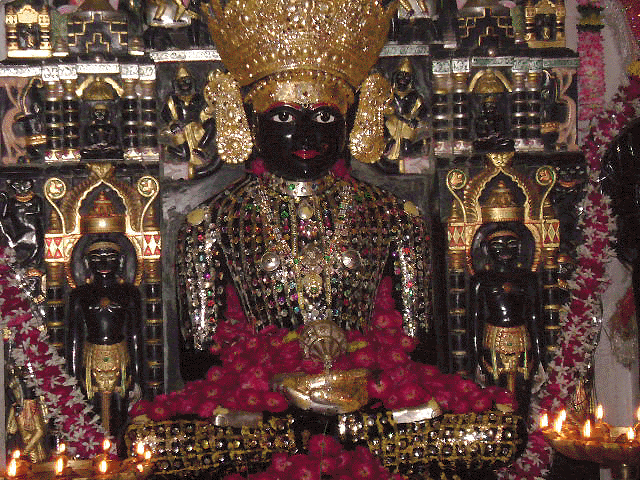Worship of Lord Brahma, Part 75
BY: SUN STAFF

Mulnayak Shri Adinath Bhagwan
Bibrod Jain Tirtha, Ratlam, Madhya Pradesh
Oct 22, CANADA (SUN) — A serial exploration of places of Lord Brahma's worship.
Lord Brahma at Pillaiyar Palayam
Today we visit an interesting temple in the Pillayar Palayam section of Kanchipuram. While no pictures have been discovered of this temple, it is known by local devotees to be a place where Lord Brahma is worshipped.
The Arulmighu Thiruloggiyanathar Swamy Temple is situated on the outskirts of Thiruparuththikkunram village, along the banks of the River Vegavathy. Thiruparuththikkunram is 4 km. southwest of the main Kanchipuram bus terminal, on the road that leads to Perumbakkam.
The presiding deity here is Thiruloggiya-nathar, also known as Adhi Bhagavan or Varthamaana Mahaaveerar (Vardhamanar). Sri Thiruloggiya-nathar is seated in meditation posture. In these names, we find a hint of the amalgamation of Lord Brahma with Shiva: 'nathar' typically refers to Brahma, while 'mahavira' refers to Shiva. There is a second shrine for Brahmadeva in the southwestern corner of the outer courtyard, and this Brahma is also in seated posture.
To the south of the presiding deity in the sanctum sanctorum there is a separate shrine for Goddess Dharma Devi. The temple's subsidiary deities include Pushpanandha-swamy Senachchaariyar, Malli Senachchariyar, Sundeerakeerthi Senachchariyar, Ananthaveeriya Senachchariyar, and Munipunga Senachchariyar.
There is a Dhvajastambha (flag pole) outside the temple, along with the Sthala Vriksha, a sacred Dharmakura tree, which is more then 2,000 years old. The temple Theertham is a holy well that was dug during the age of the Mooventhaas, the Chera, Chola and Pandiya rulers.
To the north of the Theertham is a separate shrine devoted to Munivasar (Paasunathar), who is the 23rd Theerthankarar, or divine preceptor of Jainism. The presence of this shrine obviously shows that at one time the temple was used for worship by the Jains.
The alternate name for the presiding deity, Adhi Bhagavan, is also a name for Rishabh, the first Tirthankar of the Jains, and this is a strong indication that Lord Brahma was worshipped here by the Jains. This may also indicate that Dharma Devi, situated outside the temple sanctum, is actually Saraswati, the consort of Adhi Bhagavan.
While the devotees are familiar with the Vaisnava version of Gayatri Mantra, they may be surprised to know that the Jains in South India had their own version of Gayatri. A palm leaf manuscript in Sanskrit provides evidence of the meaning the Jains ascribed to Gayatri. According to their tradition, Sri Gayatri is devoted to Adi Bhagavan–Rishabh, and by inference, to other Jain Tirthankars as well. The Jain Gayatri is said to have been worshipped by Bharata Chakravarti, the Rishis and the Ganadharas.
The Jain Gayatri Mantra is changed by the addition of a last line which, not surprisingly, the Jains consider to be 'missing' from the Hindu version of Gayatri. The additional line is:
APO JYOT RASOMRUTAM BRAHMA
The significance of this verse is perhaps best understood in the context of how the Jains adopted Adi Bhagavan as Rishabh, essentially casting him in a role combining the attributes of a king and householder deity. Jain history has it that Adi Bhagavan/Rishabh manifested at a time when the era was changing from Bhog Bhumi (a land of enjoyment without labour) to Karma Bhumi (requiring greater work for enjoyment). This transition day is still celebrated today as Ugadi, Gudi Padwaa, and the Iranian New year.
Like a king/householder deity, Adi Bhagavan/Rishabh gave various knowledge and tools to help his people flourish in Karma Bhumi. These included six branches of professional knowledge: defense, agriculture, science and engineering, arts, education, and commerce. Rishabh gave knowledge about edible plants, domestication of animals, rainwater harvesting, methods of cultivating and preserving important edible plants, and plants that produce bio-fuels. In this regard, we can appreciate the Jain's transformation of Lord Brahma into a deity who is perfectly suited for our present societal needs in Kali-yuga.
With this in mind, it is interesting to consider the added line to the Jain version of Gayatri Mantra:
APO JYOT RASOMRUTAM BRAHMA
In the Jain lexicon, the historical meaning for these terms is in blue, while their more universal meanings are in red:
APO -- the art and science of harvesting and storage of water (with the scriptures)
JYOTI -- knowledge of lighting a fire (knowledge)
RASO -- the details of food items containing six categories of culinary tastes (samarasi bhava atmika rasa)
AMRUTAM -- the utility of dairy products and dairy science and technology including animal husbandry (the secret of ending death)
BRAHMA -- the identification of food items such as cereals, fruits, nuts, etc. and methodical ways of cultivation, preservation, etc. (the art of atma vidya, or renouncement, meditation and samadhi)
When considered in the context of our Trimurti deity, Lord Brahma, and his activities on the Lord's behalf in the realm of creation, it is quite interesting to see what attributes the Jains have incorporated into this additional line of Gayatri as a reference to Adi Bhagavan/Rishabh.
We should also keep in mind, however, that there is a strong connection between Visnu and Rishabh. So the Jain connection to Brahmadeva is not conclusive, but more of an amalgamation. The Jains believe that Rishabh existed before civilization developed, and that Bharata-varsha (India) was named after his eldest son Bharat, the Chakravarti king. They say that Rishabha was born to King Nabhi Raja and Queen Marudevi at Ayodhya, in the Ikshvaku clan. According to Jain scripture, Rishabh's lifespan is 592.704 quintillion years, and the period of his practice is 1,000 years. The head of his female ascetics is Brahmi.
This Rishabha is also mentioned in the Bhagavata Purana as the eighth Lila-avatar of Visnu:
"The eighth incarnation was King Rsabha, son of King Nabhi and his wife Merudevi. In this incarnation the Lord showed the path of perfection, which is followed by those who have fully controlled their senses and who are honored by all orders of life."
(Srimad Bhagavatam 1.3.1-28)

